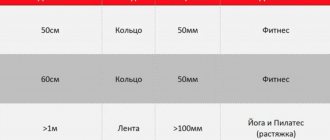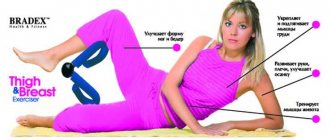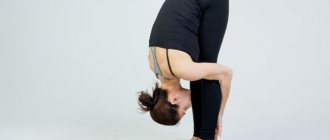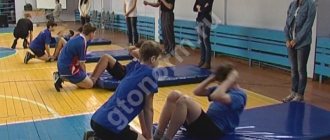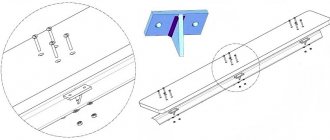Crunches with body rotation are one of the basic abdominal exercises. It involves not only the rectus abdominis and obliques, but when performed correctly, also the transverse abdominal muscle. The exercise is suitable for anyone who wants to pump up their abs, even those who exercise at home, because it does not require specialized equipment to perform. You can do it on a bench, but it is completely unnecessary.
The exercise came to us from gymnastics, where it is performed with a slight technical nuance. With each repetition, the athlete contracts the abs more and more, pushes the abdominal wall inward and rises above the floor.
Execution technique
- The starting position is the same as for a straight twist - lie on the floor or on a bench, place your heels 10 cm from the buttocks, pull in your stomach, and press your back to the floor;
- As you exhale, lift your back off the floor as if in a straight crunch;
- At the top point, hold for 1-2 seconds and inhale, and then bring your right shoulder to your left knee;
- Exhale, hold the diagonal twist position again;
- Take a neutral position while inhaling;
- Do the exercise in the opposite direction;
- Lower your back to the floor and do the required number of repetitions.
Crunches with rotation
Research on Two Types of Oblique Abdominal Exercises
Scientists recruited 17 healthy but untrained men aged 26-27 years to do two different variations of torso rotation: on a machine and with an elastic band. The photos below show various exercises.
The participants twisted from left to right, so they primarily used the right side of their core muscles. The researchers attached electromyograph electrodes to the participants' skin so they could measure how hard the muscles in those areas had to work.
Recommendations for implementation
- Use your abdominal muscles throughout the movement, do not “throw” your body down and do not fall to the floor by inertia;
- Try to train so that every movement, muscle contraction, tension is conscious, do not perform the exercise mechanically;
- Do not rest your chin on your chest or use your neck;
- If it is difficult to understand the mechanics of movement in a lying position, practice the exercise while standing, first twisting obliquely;
- Tighten the transverse abdominis muscle, drawing in your stomach;
- Try not to lift your lower back off the floor;
- Breathe slowly, this exercise is not intended for speed work at all;
- Keep your pelvis in one position, try not to tilt it from side to side.
Archives
- June 2019
- May 2019
- April 2019
- March 2019
- February 2019
- January 2019
- December 2018
- November 2018
- October 2018
- September 2018
- August 2018
- July 2018
- June 2018
- May 2018
- April 2018
- March 2018
- February 2018
- January 2018
- December 2017
- November 2017
- October 2017
- September 2017
- August 2017
- July 2017
- June 2017
- May 2017
- April 2017
- March 2017
- February 2017
- January 2017
- December 2016
- November 2016
- October 2016
- September 2016
- August 2016
- July 2016
- June 2016
- May 2016
- April 2016
- March 2016
- February 2016
- January 2016
- December 2015
- November 2015
- October 2015
- September 2015
- August 2015
- July 2015
- June 2015
- May 2015
- April 2015
- March 2015
- February 2015
- January 2015
- December 2014
- November 2014
- October 2014
- September 2014
- August 2014
- July 2014
- June 2014
- May 2014
- April 2014
- March 2014
- February 2014
- January 2014
- December 2013
- November 2013
- October 2013
- September 2013
- August 2013
- July 2013
- June 2013
- May, 2013
- April 2013
- March 2013
- February 2013
Note
This exercise is often done in combination with straight abdominal crunches, but for beginners this is not entirely true. You should do a more complex coordination exercise at the beginning, that is, it is better to make this version of twisting the first exercise in your abdominal workout.
In general, if an athlete’s workout consists of more than just abs and cardio, you can get by with just this exercise. Variations include crunches with legs raised, crunches while standing, lying down, and crunches on an incline and straight bench.
This exercise can also be performed on a block, twisting while standing obliquely.
Abdominal training should not be too long; it is enough to perform the exercise in 3-4 sets of 10-12 repetitions.
The load progression looks like this. First, they learn to retract the stomach and bring the shoulder to the opposite pelvic bone while standing, then they perform the exercise while lying down, with the heels at a distance of 10 cm from the buttocks, after which they learn to do the exercise with the heels torn off the floor and the legs raised to the “shins parallel to the floor” position.
The exercise can be included in strength training 3 times a week, or you can do it only 1 time a week, concentrating on other types of crunches on the other two days.
What is this program and who is it suitable for?
This four-week plan was suggested by From the Couch to Crushing It: A 4 Week Plan to Get Moving/Breaking Muscle by strength and conditioning coach Shane Trotter in an article on Breaking Muscle.
He claims that most of the complexes that can be found on the Internet are too complex for beginners. Heavy exercises and intense formats frighten beginners, overwork the body, which is not ready for the load, and kill motivation.
There is not a single complex exercise in Trotter’s program - all movements are performed smoothly and calmly, warming up and gently stretching the muscles. Small complexes take about 10 minutes and are designed for every day.
This approach helps to form the habit of movement, smoothly return the body to physical activity, enjoy it and not lose the desire to exercise.
The Trotter program is suitable for anyone who has long reduced their physical activity - led a sedentary lifestyle or refused to exercise due to injury. And also for older people and those who are significantly overweight.
However, if you have health problems, you should still consult a doctor before starting classes.
Errors
- Pushing the abdominal wall forward;
- Swing shoulder to hip and rise by inertia;
- Holding your breath while twisting and lowering your body;
- Displacement of the pelvis from side to side;
- Neck work throughout the entire amplitude
- Efficiency Tips
- Remember that the main movement here is not twisting to the side, but lifting the body forward with the abdomen drawn in. If this movement is missing, the athlete will simply over-tighten the obliques and neck;
- The lower back must be pressed to the floor, it should not be arched upward;
- Abdominal tension is maintained consciously, that is, the athlete should not let go of mental concentration;
- This seemingly simple exercise can be made more challenging by reaching with your shoulder to your hip, truly drawing in your stomach rather than relaxing your anterior abdominal wall.
The exercise is contraindicated during pregnancy, diseases of the spine, including hernias and protrusions, as well as disorders in the hip joints. Movement is temporarily suspended for intercostal neuralgia.
As for the popular “horror story” about waist growth from this exercise, it has nothing to do with reality.
We pump up the press at home. Lying crunches with twists for the oblique abdominal muscles. Video exercises for the press.
Igor June 1, 2020
How to properly train a woman's abs
What is the secret to a beautiful belly? The answer is obvious - constant training, statics and proper nutrition. This applies to representatives of the fair half who are far from big sports and engage in it solely for their health. Here are some useful tips that will make the process of working out the abdominal area much more effective:
- It is advisable to do abdominal exercises for women in the format of supersets, consisting of several elements, at a slow pace in one approach. This way the load will be distributed evenly and the white muscle fibers will not grow rapidly. As a result, the tummy is well pumped up, but remains flat.
- We definitely include static tension in the training process. It involves short pauses at the maximum point of each exercise.
- We pay special attention to breathing. Maximum muscle fiber contraction occurs with full exhalation. To increase efficiency, it is necessary to achieve a greater range of motion.
Note. Before training, be sure to study video lessons from famous instructors. Let's look at each exercise step by step.
- To pump up the abs, a woman only needs one lesson weekly. All other workouts must be devoted to other muscle groups, not forgetting about cardio training.
Pros and cons of Russian crunches
Pros of the exercise:
- Thanks to the peculiarities of the technique, the exercise trains not only the external abdominal muscles, but also the internal ones, which are responsible for maintaining the spine and the correct position and functioning of the internal organs. Relaxed internal abdominal muscles cannot hold the lower back in the correct position, which causes lumbar hyperlordosis to form.
- The exercise, when performed in large numbers of repetitions, forms a muscle corset, visually improves the shape of the muscles and indirectly helps to reduce waist size, especially with the right loads and nutrition. Exercise itself does not burn fat locally in this area. And lifting weights makes the muscles thicker and more defined.
The disadvantage of the twist is that the oblique twisting technique is not suitable for everyone, namely for problems with the spine - hernia, protrusion, pinched nerve endings, osteochondrosis and displacement of the vertebrae. Even in healthy people, performing a twist incorrectly can cause back pain. Therefore, it should be performed with good physical preparation and master the technique first without weights.
Training cycles. Pull-up diagram on the horizontal bar
If, after taking the test, you find that you have completed less than five pull-ups, then you need to start your training with pull-ups such as negative pull-ups. Now, a few words about how negative pull-ups are performed.
You need a support with which to hang on the bar at the top - your chin on top of the bar, but you don't need to put it on it. Now you need to lower yourself until your arms are completely straight, as slowly as possible. Then repeat as many times as needed.
| Day | Sets and reps | Total | ||||
| First | 1 | 7 | 5 turns | 5 | 7 times | 26 |
| Second | 2 | 8 | 6 turns | 6 | 8 times | 31 |
| Third | 3 | 9 | 6 turns | 6 | 8 times | 33 |
| Fourth | 4 | 9 | 7 turns | 7 | 9 times | 37 |
| Fifth | 5 | 10 | 8 turns | 8 | 10 times | 41 |
| Sixth | 6 | 10 | 8 turns | 8 | 12 times | 44 |
4-5 reps
In this cycle, as in the previous one, you will need to do negative repetitions.
| Day | Sets and reps | Total | ||||
| First | 4 | 9 | 6 turns | 6 | 9 times | 34 |
| Second | 5 | 9 | 7 turns | 7 | 9 times | 37 |
| Third | 6 | 10 | 8 turns | 8 | 10 times | 42 |
| Fourth | 6 | 11 | 8 turns | 8 | 11 times | 44 |
| Fifth | 7 | 12 | 10 turns | 10 | 12 times | 51 |
| Sixth | 8 | 14 | 11 turns | 11 | 14 times | 58 |
6-8 reps
| Day | Sets and reps | Total | ||||
| First | 2 | 3 | 2 turns | 2 | 3 times | 12 |
| Second | 2 | 3 | 2 turns | 2 | 4 times | 13 |
| Third | 3 | 4 | 2 turns | 2 | 4 times | 15 |
| Fourth | 3 | 4 | 3 turns | 3 | 4 times | 17 |
| Fifth | 3 | 5 | 3 turns | 3 | 5 times | 19 |
| Sixth | 4 | 5 | 4 turns | 4 | 6 times | 23 |
9-11 reps
| Day | Sets and reps | Total | ||||
| First | 3 | 5 | 3 turns | 3 | 5 times | 19 |
| Second | 4 | 6 | 4 turns | 4 | 6 times | 24 |
| Third | 5 | 7 | 5 turns | 5 | 6 times | 28 |
| Fourth | 5 | 8 | 5 turns | 5 | 8 times | 31 |
| Fifth | 6 | 9 | 6 turns | 6 | 8 times | 35 |
| Sixth | 6 | 9 | 6 turns | 6 | 10 times | 37 |
12-15 reps
| Day | Sets and reps | Total | ||||
| First | 6 | 8 | 6 turns | 6 | 8 times | 34 |
| Second | 6 | 9 | 6 turns | 6 | 9 times | 36 |
| Third | 7 | 10 | 6 turns | 6 | 9 times | 38 |
| Fourth | 7 | 10 | 7 turns | 7 | 10 times | 41 |
| Fifth | 8 | 11 | 8 turns | 8 | 10 times | 45 |
| Sixth | 9 | 11 | 9 turns | 9 | 11 times | 49 |
16-20 reps
| Day | Sets and reps | Total | ||||
| First | 8 | 11 | 8 turns | 8 | 10 times | 45 |
| Second | 9 | 12 | 9 turns | 9 | 11 times | 50 |
| Third | 9 | 13 | 9 turns | 9 | 12 times | 52 |
| Fourth | 10 | 14 | 10 turns | 10 | 13 times | 57 |
| Fifth | 11 | 15 | 10 turns | 10 | 13 times | 59 |
| Sixth | 11 | 15 | 11 turns | 11 | 13 times | 61 |
| Seventh | 12 | 16 | 11 turns | 11 | 15 times | 65 |
| Eighth | 12 | 16 | 12 turns | 12 | 16 times | 68 |
| Ninth | 13 | 17 | 13 turns | 13 | 16 times | 72 |
21-25 reps
| Day | Sets and reps | Total | ||||
| First | 12 | 16 | 12 turns | 12 | 15 times | 67 |
| Second | 13 | 16 | 12 turns | 12 | 16 times | 69 |
| Third | 13 | 17 | 13 turns | 13 | 16 times | 72 |
| Fourth | 14 | 19 | 13 turns | 13 | 18 times | 77 |
| Fifth | 14 | 19 | 14 turns | 14 | 19 times | 80 |
| Sixth | 15 | 20 | 14 turns | 14 | 20 times | 83 |
| Seventh | 16 | 20 | 16 turns | 16 | 20 times | 88 |
| Eighth | 16 | 21 | 16 turns | 16 | 20 times | 89 |
| Ninth | 17 | 22 | 16 turns | 16 | 21 times | 92 |
26-30 reps
| Day | Sets and reps | Total | ||||
| First | 16 | 18 | 15 turns | 15 | 17 times | 81 turns |
| Second | 16 | 20 | 16 turns | 16 | 19 times | 87 turns |
| Third | 17 | 21 | 16 turns | 16 | 20 times | 90 rev. |
| Fourth | 17 | 22 | 17 turns | 17 | 22 times | 95 |
| Fifth | 18 | 23 | 18 turns | 18 | 22 times | 99 |
| Sixth | 19 | 25 | 18 turns | 18 | 24 times | 104 |
| Seventh | 19 | 26 | 18 turns | 18 | 25 times | 106 |
| Eighth | 19 | 27 | 19 turns | 19 | 26 times | 110 |
| Ninth | 20 | 28 | 20 turns | 20 | 28 times | 116 |
31-35 reps
| Day | Sets and reps | Total | ||||
| First | 20 | 25 | 19 turns | 19 | 23 times | 106 |
| Second | 22 | 25 | 21 turns | 21 | 25 times | 114 |
| Third | 23 | 26 | 23 rev. | 23 | 25 times | 120 |
| Fourth | 24 | 27 | 24 turns | 24 | 26 times | 125 |
| Fifth | 25 | 28 | 24 turns | 24 | 27 times | 128 |
| Sixth | 25 | 29 | 25 turns | 25 | 28 times | 132 |
| Seventh | 26 | 29 | 25 turns | 25 | 29 times | 134 |
| Eighth | 26 | 30 | 26 turns | 26 | 30 times | 138 |
| Ninth | 26 | 32 | 26 turns | 26 | 32 times | 142 |
36-40 reps
| Day | Sets and reps | Total | ||||
| First | 23 | 27 | 22 turns | 22 | 26 times | 120 |
| Second | 24 | 28 | 24 turns | 24 | 28 times | 128 |
| Third | 25 | 29 | 24 turns | 24 | 29 times | 131 |
| Fourth | 26 | 30 | 25 turns | 25 | 30 times | 136 |
| Fifth | 26 | 31 | 25 turns | 25 | 31 times | 138 |
| Sixth | 26 | 31 | 26 turns | 26 | 26 times | 135 |
| Seventh | 27 | 31 | 26 turns | 26 | 32 times | 142 |
| Eighth | 28 | 32 | 26 turns | 26 | 32 times | 144 |
| Ninth | 28 | 34 | 27 turns | 27 | 34 times | 150 |
More than 40 repetitions
| Day | Sets and reps | Total | ||||
| First | 25 | 28 | 24 turns | 24 | 27 times | 128 |
| Second | 25 | 29 | 25 turns | 25 | 28 times | 132 |
| Third | 25 | 30 | 25 turns | 25 | 29 times | 134 |
| Fourth | 26 | 31 | 25 turns | 25 | 31 times | 138 |
| Fifth | 26 | 32 | 26 turns | 26 | 31 times | 141 |
| Sixth | 27 | 32 | 26 turns | 26 | 26 times | 137 |
| Seventh | 27 | 34 | 26 turns | 26 | 33 times | 146 |
| Eighth | 28 | 34 | 26 turns | 26 | 34 times | 148 |
| Ninth | 29 | 35 | 27 turns | 27 | 35 times | 153 |
Here is a pull-up program on the horizontal bar, with which you can achieve pretty good results. This bar training program will help you in any case, no matter how many pull-ups you want to do. This can be either 20 or 30 times - you can use this program. But one pull-up pattern on the horizontal bar is good, but two are better
And the second pull-up program is a pull-up diagram that will help you get to 25 pull-ups on the bar.
But one pull-up pattern on the horizontal bar is good, but two are better. And the second pull-up program is a pull-up circuit that will help you get to 25 pull-ups on the bar.
What exercises with dumbbells will pump up your shoulders?
Standing Dumbbell Press
Raise the dumbbells to shoulder level, open your chest, and squeeze your shoulder blades together. Now lower your shoulders. Press the dumbbells up and slightly behind your head. Lower them to the starting position and repeat.
Dumbbell flyes
Raise your arms with dumbbells to the sides to shoulder level, lower them back and repeat. Bend your elbows slightly so as not to overload your joints.
Bent-over dumbbell raises
Tilt your body until it is parallel to the floor, slightly bend your knees. Extend your arms with dumbbells to the sides to shoulder level and return them back. Perform the movement smoothly, without jerking. Do not change your body position until the end of the exercise.

